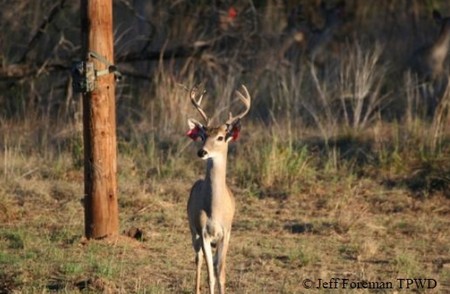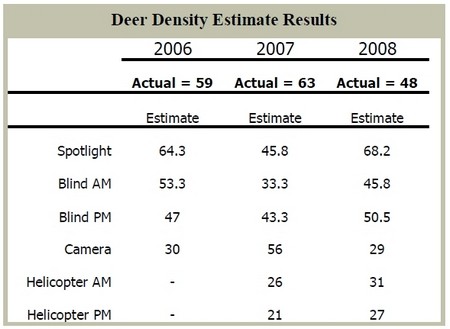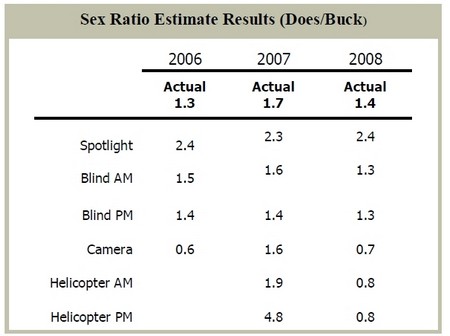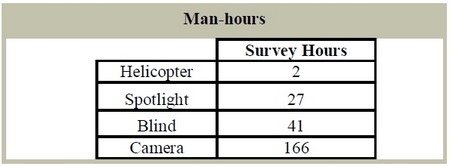There are no shortcuts when it comes to white-tailed deer management, especially when dealing with native whitetail on small acreages. The trend, at least in Texas, is smaller properties with taller fences. Land costs have risen consistently for the last decade, so folks are buying less land, but developing the necessary infrastructure to manage their smaller properties to the best of their abilities. In fact, high fenced ranches of 500 acres in size or less are now the norm when it comes to landowners interested in high quality deer management. But a smaller property does not make it easier.
Regardless of ranch size, white-tailed deer management involves the same basic principles. Population size, sex ratio, recruitment and age structure are all important considerations when making management decisions. To measure these parameters deer managers have a vast array of methods to choose from, but each has its own applicability to specific situations. The suitability of these methods to yield accurate results is critical when managing a small, enclosed population of deer.
Texas Parks and Wildlife Department (TPWD) biologists began a three year study (2006-2008) to evaluate deer survey methods within a 528 acre high fenced enclosure that contained a known population of whitetail deer. Each year, deer were trapped, marked and relocated to the study site on Mason Mountain Wildlife Management Area (WMA) during late winter and early spring. Surveys were conducted in August and September of each year, and then all deer were removed afterward to determine the actual population in the enclosure. Many survey methods were evaluated which included spotlight, stand (hunting blind) counts, game cameras and helicopter surveys. Each year TPWD compared estimated population results with the actual population of deer and evaluated the time required to perform each method.

According to Ryan Reitz, TPWD biologist at Mason Mountain WMA:
“SURVEY METHODS
We conducted traditional spotlight surveys on a predetermined route approximately 45 minutes after sundown. We used 1driver and 2 observers equipped with 100,000 candle-power spotlights. Spotlight routes were conducted four times in late August, with no bait (corn) present. We conducted helicopter surveys in 2007 and 2008 with a privately contracted helicopter pilot and 1 observer. The entire study area was surveyed in the morning and in the evening using transects spaced approximately 200 yards apart. The total whitetail deer observed served as the population estimate. Blind count and game camera survey methods required bait in order to be useful. We utilized 5 spin-cast corn feeders evenly distributed across the pasture that were programmed to feed in the morning and in the evening. Deer became accustomed to the feeders for a minimum of 14 days before surveys began.
For the blind count method we had 1 observer in each blind recording the number and sex of deer visiting baited sites for 2 hours in the morning and 2 hours in the evening. The blind count estimate was the combined sum of all unique observations during each survey period. We repeated deer surveys 4 times in the evening and 4 times in the morning. The mean of the 4 surveys served as the population estimate. Since all deer were marked we were able to determine if deer visited multiple baited sites and if observers were able to accurately record only unique deer.
Digital game cameras were operated for 14 days at the baited sites. We analyzed the photographs and determined the number of unique branch-antlered deer and calculated the number of spikes, does and fawns from photographic occurrence as published by Jacobson et al. (1997) ‘Infrared-triggered cameras for censusing white-tailed deer.’
For example, we identified 20 different branch-antlered bucks from 3,195 photographs collected in 2007. We counted 1,349 branch-antlered bucks and 64 spike-antlered bucks in the photographs which equaled a .047 spike-antlered buck occurrence or ‘factor.’ We applied that factor to the number of unique branch-antlered bucks to estimate the total number of bucks in the population.
20 *0.047 = 0.94 which we rounded to (1 spike)
This method calculated 1 spike in the population and estimated a total of 21 bucks. This process was repeated in a similar manner to determine the doe and fawn population estimate.
RESULTS
Our results demonstrated no single survey method was superior in estimating herd density across all 3 years (see table). We observed both underestimating and overestimating of the true population with spotlight and blind counts in the evening (PM). Morning (AM) blind counts, game cameras and helicopter surveys underestimated density in all 3 years. Helicopter surveys ranged from 33-65% accuracy and tended to yield the lowest estimates— except in 2008 when it exceeded camera estimates. Morning helicopter surveys resulted in a slightly higher estimate than evening surveys. Blind counts had an accuracy rate of 53-95% and camera surveys ranged from 51-89%.

Approximately 1 out of every 7 observations (15%) of deer in blind surveys was double counted (same deer recorded at more than one blind). However, observers were able to identify 99% of deer that had previously visited their bait site. In summary, deer that visited multiple blinds were recorded more than once, but deer that returned to the same blind were not.
For estimating sex ratios, blind counts, particularly in the morning (AM), were most accurate. Spotlight surveys tended to be biased toward does, and conversely the camera survey showed bias toward bucks. Helicopter sex ratio estimates were variable and showed a bias toward does in 2007 and a bias toward bucks in 2008.
Given these results, the time required to conduct each deer survey method becomes even more important. The two most time consuming techniques were the camera and blind surveys. Although camera surveys took a relatively short time to setup (6 hrs), many hours were required to examine and identify deer in the pictures (160 hrs). Conversely, many hours were required to collect data in the field for blind surveys as 5 observers were needed for each survey (40 hrs), but survey hours for data analysis were few (1 hr). Spotlight and helicopter methods required much less survey effort.

Simply choosing a tool that is speedy, handy and familiar (remember that pocket knife?) may not be wise when deciding how to survey a property. Although we discovered some variability in all methods, some positive attributes were evident. The camera estimate was effective in capturing buck images and allowed us to identify 98% of branch antlered deer by day 7 of the 14 day survey. Although blind surveys resulted in biased population estimates in any given year, observed sex ratios were more consistent across years than all other methods. These results indicate that perhaps a combination of these two methods may provide the basis for a better way to survey deer on small acreages and that this type of survey becomes increasingly more advantageous as ranch size decreases.

While an improved deer population estimate may be feasible, our data indicate that complete accuracy and precision may not be possible. Deer survey limitations need to be thoroughly considered when working with population estimates. Moreover, these estimates should never become the sole reference on which to base deer management decisions. Other factors such as harvest data trends (age, weight and antler measurements) and habitat evaluations should be incorporated into the decision making process. Knowledge of both the limitations in the available tools and the required time investment will assist managers in not only choosing the best survey method for their ranch, but also aid them in interpreting the data they obtain to make their deer management plan work the best for them.”
I have been surveying deer for eight years…. learning as I go. I have found that blind surveys must be averaged to accommodate double counts. Fawns cannot be surveyed in the way that does are as they are born at different times. I spend most of my time identifying individual fawns which takes from April to September. However, taking this amount of time gives me the best results. By identifying each individual fawn by spots over a longer time will give a larger number and more accurate.
So… I can get bucks and fawns about 90% accurate… however, relying on buck/doe ratios for a doe number is least accurate. By using a very large collection of numbers… the overall number becomes more in line.
J. Miller, I think you are hovering around the intended message. Basically, if a sound survey method is used, then the more time you put into estimating deer numbers the better the overall estimate will be. Having the ability to ID fawns by spots is great, but no doubt requires more time than most hunters or managers have to spare. Most traditional methods for estimating annual fawn numbers underestimate fawns, but that is also the assumption since these animals are smaller, more difficult to see and not always visible during the survey period. Thanks for taking time to chime in!